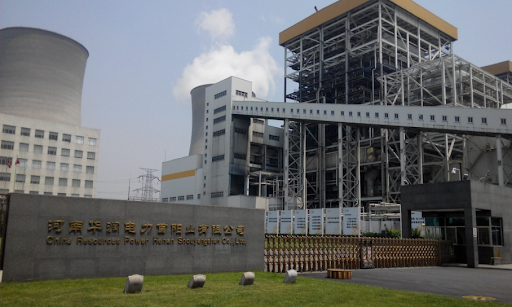
Shou Yang Shan Unit 2 Boiler and Its Upgrade and Optimization:
Boiler Description of Unit 2:
Type: Supercritical parameter variable pressure operation with an internal recirculation pump startup system, Benson type once-through boiler.
-
- Features: Single furnace, single reheat, balanced ventilation, open-air layout, solid slag discharge, all-steel frame, fully suspended structure, Π-type boiler.
- Model: HG-1987/25.4-YM1.
- Design Efficiency: 93.71%.
- Turbine: Intermediate reheat, single-shaft, triple-cylinder, four-exhaust, double back pressure condensing steam turbine, model N600-24.2/538/566, with a design thermal consumption of 7747kJ/(kW˙h).
-
In July and August of 2019, a notable upgrade was made to Unit 2 with the installation of 36 low NOx burners and other related components by Sunco International Inc. This upgrade was a part of an initiative to enhance the unit's operational efficiency and environmental performance. Here are the key points of this achievement:
-
Installation of Low NOx Burners: The core of this upgrade was the installation of 36 low nitrogen oxide (NOx) burners. These burners are designed to reduce the emission of NOx, which is a significant pollutant produced during the combustion process.
-
Additional Component Installation: Along with the low NOx burners, other related components were also installed to support the unit's improved functionality. These components likely included systems for better fuel-air mixing, combustion control, and monitoring.
-
Successful Commissioning: Following the installation, Unit 2 was successfully commissioned. This process involved thorough testing and adjustments to ensure that all new components were functioning correctly and integrated seamlessly with the existing system.
-
Achievement of Record Low NOx Levels: One of the most significant outcomes of this upgrade was the achievement of record low levels of NOx emissions. This indicates a substantial improvement in the unit's environmental performance.
-
Best Combustion Performance: Along with reduced NOx emissions, the unit also demonstrated the best combustion performance. This implies more efficient fuel usage, leading to better overall operational efficiency of the unit.
-
Enhanced Unit Efficiency: The combination of lower NOx emissions and improved combustion performance contributed to an overall enhancement in the efficiency of Unit 2. This means that the unit could generate more power from the same amount of fuel while reducing its environmental impact.
This project reflects a commitment to environmental sustainability and operational efficiency in power generation, showcasing advancements in technology and responsible management of environmental impacts. Unit 2 was burning 55-65% anthracite with extremely high ash and low volatile content during normal operation.
-
-
Turbine Transformation: On November 20, 2020, the low-pressure cylinders A and B of the No. 2 steam turbine unit achieved zero output operation. This marked the first time a 600 MW-level imported unit in China successfully completed the zero-output transformation of its low-pressure cylinder and operated smoothly.
-
Retrofit Timeline: The unit began its technical transformation on September 30, 2020. The process took 45 days, including the time for rotor cooling. The transformation involved the low-pressure cylinder, heat recovery system, and heating system.
-
Successful Grid Connection: The unit was successfully connected to the grid on November 14, 2020, after the completion of the transformation.
-
Record-Breaking Achievement: This project broke the construction period record for the transformation of a domestic 600 MW steam turbine unit's low-pressure cylinder to zero-output operation. It stands as the first such unit to achieve successful zero-output low-pressure cylinder operation in the year 2020.
This accomplishment represents a significant advancements in the operational efficiency and environmental performance of the large power generation unit, especially in the context of supporting increased renewable energy integration. Here's an overview of the key outcomes:
-
Lower NOx Emissions: The reduction in nitrogen oxides (NOx) emissions is a crucial environmental improvement. NOx gases are harmful pollutants that contribute to smog and acid rain. The successful lowering of these emissions, especially in a unit burning high-ash, low-volatile anthracite, is a notable achievement.
-
Reduced Unburnt Carbon in Ash (UBC): Achieving lower levels of unburnt carbon in ash indicates more efficient combustion. Unburnt carbon in ash is a waste of fuel and can impact the efficiency of ash handling systems and the environmental footprint of the plant. Reducing UBC not only improves efficiency but also reduces waste.
-
Higher Boiler Efficiency: Improved boiler efficiency means that the unit is able to extract more energy from the same amount of fuel. This is particularly important given the challenging nature of the fuel used (high-ash, low-volatile anthracite). Higher efficiency directly translates to cost savings and reduced environmental impact.
-
Excellent Flame Stability: Maintaining flame stability is crucial for efficient combustion, especially when operating under varying load conditions. Excellent flame stability ensures consistent and efficient combustion, which is essential for operational reliability and safety.
-
Operation at 13.7% of Design Load: The ability to operate efficiently at only 13.7% of the design load level is remarkable. This low-load operation capability is crucial for integrating more renewable energy sources into the power grid. As renewable energy sources like wind and solar are intermittent, the ability to efficiently scale down the operation of conventional power units like this one allows for better balancing of the grid when renewable energy generation is high.
-
Support for Renewable Energy: The enhanced low-load operation capability of the unit aligns with the broader goal of increasing the use of renewable energy. By efficiently operating at lower loads, the unit can complement renewable sources, stepping in to provide power when renewable generation is low, and scaling back when it's high, thereby supporting a more sustainable and flexible energy grid.
Overall, these improvements demonstrate a successful application of technology and operational strategies to enhance efficiency, reduce environmental impact, and support the integration of renewable energy sources into the power grid.
